Michigan vegetable crop report – July 17, 2024
After lots of rain in many areas last week, the weather for the next week will be ideal for plants and people.

Weather
For the past week, temps were 2-4 degrees Fahrenheit above normal. Degree-day totals (base 50F) are several days to a week ahead of normal for the lower peninsula, but behind in the Western Upper Peninsula. The big story was high rainfall.
Most regions of SW Michigan have received over 2 inches of rain since last week’s report, spread across two separate weather events on July 7, 8, 9, 10 and July 14-15. The average across the 24 Enviroweather stations in SW Michigan was 4.54 inches of accumulated rain. From mid-June to now, many areas have received 200% more rain than normal. Farms in areas on the high end of that range are dealing with water ponding over plants and plastic mulch, washouts and channelization in plasticulture fields, and are pumping water out of fields. Some vegetables are more tolerant of saturated soils than others, but there will be losses and sections of plantings that growers may need to walk away from.
The forecast for this week predicts:
Partly cloudy and cooler Wednesday. Scattered showers possible in the North and East. Fair, dry and seasonably cool Thursday through early next week.
- High temperatures from the upper 60s North to upper 70s South Wednesday warming slightly to the mid-70s North to low-80s South by early next week. Low temperatures from the mid-40s North to mid-50s South Thursday increasing to the 50s North to low-60s by early next week.
- Less than 0.25 inches of rain for the upcoming week.
- Near to slightly above normal daily PET rates during the upcoming week (daily values from 0.17-0.19 inches).
- Medium-range outlooks generally call for a slow transition to warmer-than-normal temperatures again by late July. Normal to above-normal precipitation totals are also expected.
Compaction
Despite the rain stopping we still have very wet soils. In fact, many soils in Michigan are near 100% saturation. Caution should be taken when in the field, minimizing heavy equipment and choosing tillage systems that cause less compaction. Tillage equipment that turns the soil can result in breaking up the soil structure that you worked so hard to build.
Foliar Fertilizing
Foliar fertilizing is an important tool when heavy rains leach nutrients, or when plants need some nutrients but soils are too wet to apply with ground-rigs or drip-tape. This University of Missouri article details some considerations for making these practical applications.
Produce Food Safety On-Farm Readiness Reviews
On May 2, the U.S. Food and Drug Administration (FDA) released their final revisions to the Food Safety Modernization Act Produce Safety Rule Pre-Harvest Agricultural Water Rule. If you are a grower in Michigan, this is a great time to schedule an On-Farm Readiness Review (OFRR). Not only can our team help you assess your on-farm produce safety risks, we can help you assess your water system in light of the updated water rule. If you have already had an OFRR on your farm, no problem, we are happy to come back out to help you assess your water system based on the new parts of the water rule.
An On-Farm Readiness Review (OFRR) is an opportunity for a grower to walk around their farm with their local conservation district produce safety technician and a produce safety specialist from Michigan State University Extension. These 2-hour educational visits take place during the harvest season and are meant to be casual and low stress. Everything discussed during an OFRR is confidential and focused on ways a grower can reduce their own risks in relation to produce safety. There is no pressure to take our advice either, we are just here to support you in your produce safety efforts!
Crop updates
Asparagus
In some fields, there is a mix of older and newer fern, possibly due to continued flushes with frequent rains. New fern was continuing to develop in some West Central fields, with cladophylls (leaves) just starting to unfold on some shoots.
Between 7 and 11 Disease Severity Values (DSVs) accumulated July 9-15 across five asparagus fields where MSU and consultants have weather sensors. Fungicide applications can be made every 15 DSVs to protect against purple spot. Keep in mind that a DSV of zero or one for a 24-hour period indicates that the weather during that time period was not favorable for disease development. A DSV of 2 for a 24-hour period indicates that the weather is moderately favorable for disease. When a DSV of 3 is attained within a 24-hour period, then the weather is especially conducive for disease and indicates a long leaf wetness period with favorable temperatures. We rarely see a DSV of 4 in a 24-hour period. The rapid accumulation of DSVs in a relatively short period of time would indicate the need to use a locally systemic fungicide such as Quadris (azoxystrobin) which could be tank mixed with either mancozeb (Roper) or chlorothalonil (Bravo WeatherStik) with each at the full labeled rate.
Asparagus rust can be an issue in locations that had infestations the previous year, or in adjacent fields. Once epidemics have started, it is difficult to play catchup, even with our best rust fungicide, tebuconazole. Early protection is important, but especially tough in young fields, which go to fern early, creating an extended fern protection season that starts when growers are busy harvesting. If rust has become established, it is important to protect the remaining green tissue. Up to three applications of tebuconazole 3.6F formulations (at 4-6 fl. oz./acre) are allowed per season. Tank mixing tebuconazole with chlorothalonil is advised to achieve enhanced protection and control of foliar disease.
Brassicas and greens
High leafhopper pressure can bring infections from aster yellows in lettuce. Infectivity rates of leafhoppers is high this year, meaning it takes fewer leafhoppers to transmit the disease. For information on aster leafhopper thresholds and aster yellow infectivity risk, check out this recent article from Zsofia Szendrei and consider signing up for the text alert system.
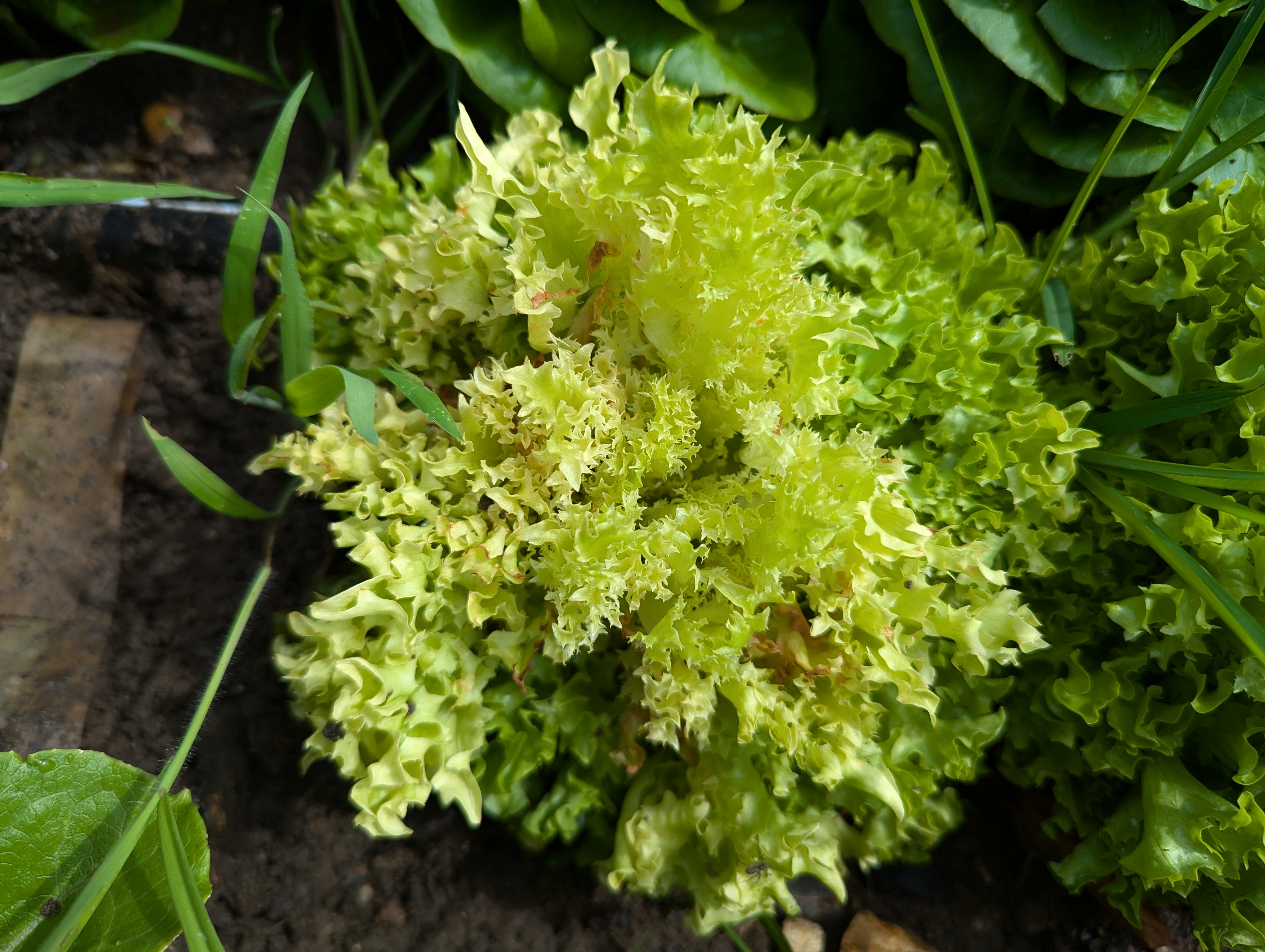
Bottom rot has been a problem in some lettuce fields. This disease is caused by Rhizoctonia solani, a fungal, soil-borne pathogen. Once disease is evident on a nearly finished crop the control options are limited. Growers in this situation should consider strategies to reduce potential future disease problems including tillage and plowing to facilitate breakdown of remaining plant material.

Broccoli, kohlrabi, some cabbage, kale and salad mixes of all types are flowing into markets with new plantings being established. All caterpillars and beetles can be found, with thrips as well in some situations.
In a trial evaluating broccoli varieties for summer-harvest last year, there were some clear signs of stress. I planted a few top and bottom performers from the larger trial last year to see if they behaved similarly this year. Quality looks better than last year in general, but the varieties performed similarly in their timing to maturity and head features. ‘Eastern Crown’ and ‘Fletcher’ are earliest in reaching large sizes, with ‘Fletcher’ exhibiting the same irregular coloring as last year and a consistent and concentrated flat-topped head on most plants in the plot, and ‘Eastern Crown’ pushing bracts through the main head again with a range of head sizes maturing at different rates. ‘Imperial’ and ‘354B’ are sizing slower, with ‘Imperial’ pushing non-uniform beads. In last year’s trial ‘354B’ was the top performer and is making a good show again this year, with its tight and consistent bead and tall dome, with a small amount of bracts pushing through.
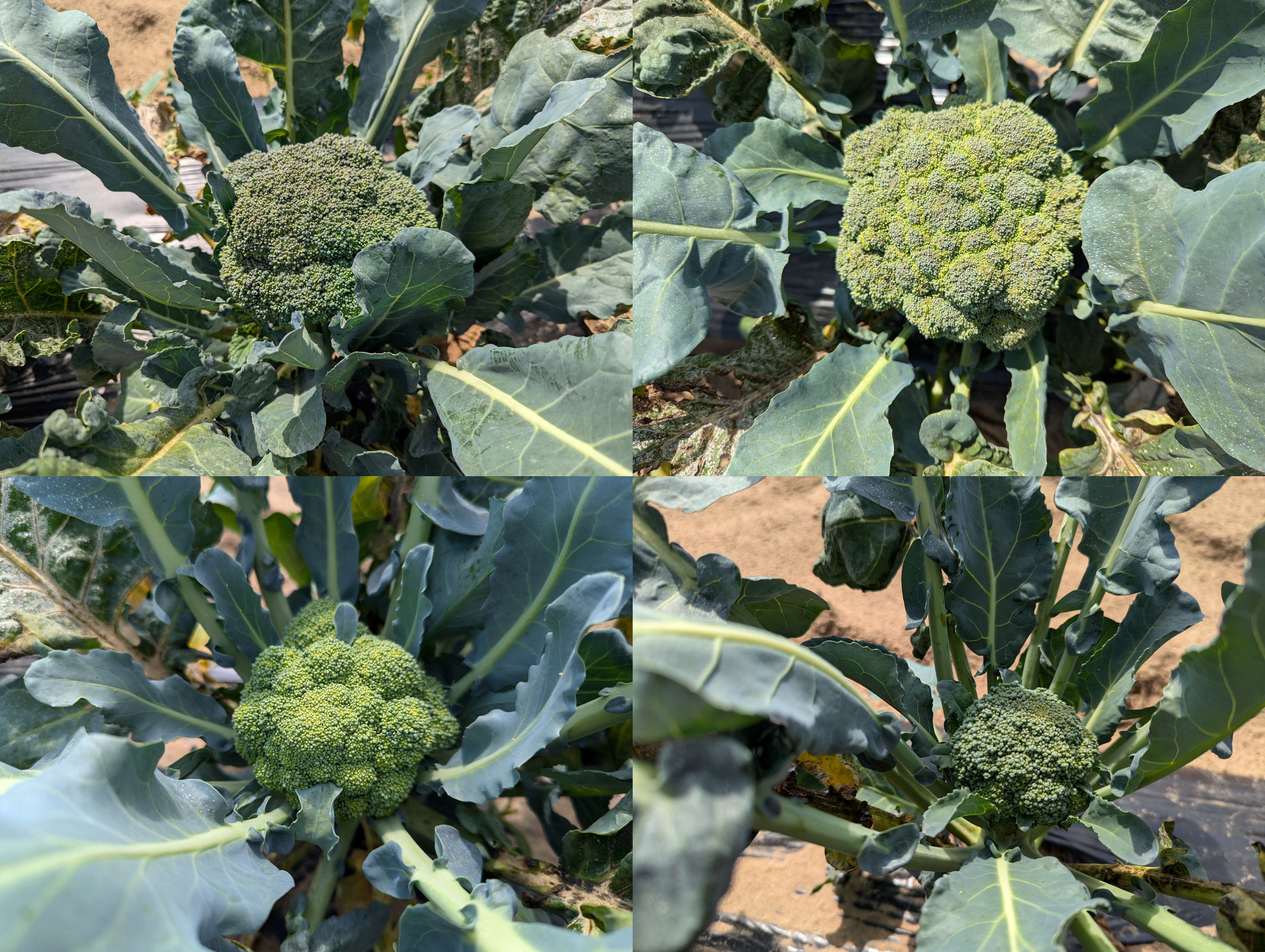
Sometimes it is helpful to see how a disaster resolves itself. Here is a zoomed-out picture of the broccoli from above, but in this shot you can see how all the old leaves are burned up and distorted. This is from an accidental overapplication of an adjuvant. Luckily the growing point wasn’t burned up and the plants pushed out new healthy leaves and nice-looking heads.

Carrots and celery
Foliar leaf blights of carrots caused by Cercospora or Alternaria may be expected to develop their first symptoms during this time and preventive applications are needed. Previous MSU research has shown that once blight is well established in a field, it becomes especially difficult to turn the situation around even with an aggressive fungicide program.
Keep in mind that there is also a bacterial blight of carrots that can mimic the leaf lesions caused by the Cercospora and Alternaria fungi. Since the control for blight caused by fungi and bacterial disease differs, it is important to always know which plant pathogen is causing the problem.
For information on aster leafhopper thresholds and aster yellow infectivity risk, check out this recent article from Zsofia Szendrei and consider signing up for the text alert system.
Cucurbits
Mechanical harvest of pickles has begun. Bacterial wilt and different viruses have been reported in cucurbits.
Just in the last week, downy mildew was detected on cucumbers in additional counties on the eastern side of the state and in Ingham County. The MSU Extension news story contains fungicide recommendations for 2024. Keep up to date on the development of this destructive cucurbit disease at the Hausbeck Downy Mildew News website.
All cucumber and melon growers should be on a preventive and aggressive fungicide program, based on the rapid uptick in disease along with the wet and humid weather that some areas of the state have experienced. The qPCR results indicate that the pathogen is Clade 2 which favors cucumber and melon. At this time, it appears that the pumpkins and squash are not at high risk for infection. The pathogen has become established nearly three weeks earlier this year compared to 2023 and there is still a long growing season for both pickling cucumbers and slicers. It may be advisable to shorten spray application intervals to protect vulnerable crops during wet and humid periods as this pathogen can be explosive when the weather is favorable.
Michigan producers are experiencing significant losses in squash and cucumber from Phytophthora capsici following some heavy rains in the state. With the recent heavy downpours that some regions have experienced, it is likely that disease symptoms will increase and cause additional plant death. The most obvious symptoms on the fruits are white spores that look similar to powdered sugar on the fruit surface. The infected fruits rot as secondary organisms invade including soft rot bacteria. It is possible to harvest fruits that look healthy, but symptoms of Phytophthora can appear days later while the crop is in transit or on grocers’ shelves. Lesions may appear on the foliage under wet conditions but aren’t very common. The best way to protect crops from Phytophthora is to apply recommended fungicides before an outbreak.
If Phytophthora develops, disc under the diseased plants and the surrounding, healthy-looking border plants. Work problem fields last and powerwash the equipment to prevent spread to other areas. This Phytophthora pathogen can spread from field to field via soil particles clinging to field equipment. Discard diseased fruit in an area where crops will not be grown in the future. It is recommended that hard squash and pumpkins can be planted into raised beds so that excess water moves away from the susceptible root and crown area.
If a parcel has a known history of Phytophthora infestation, applying fungicides preventively is recommended. MSU studies have shown that green zucchini is less susceptible to Phytophthora than crookneck yellow squash. Some types of hard squash are more resistant than others.
We compared four Butternut types (Cucurbita moschata), two Delicious varietal Hubbard types (Cucurbita maxima), and six Kabocha types (C. maxima) for crown rot resistance. The C. moschata cultivars Dickinson, Buckskin, New England Cheddar, and Ultra Butternut had significantly less plant death in two years (<15%) than other cultivars. Significantly fewer Thunder plants died (59.6%) compared with the Kabocha cultivars Sweet Mama (>94.2%), Delica (≥92.3%), and Sunshine (≥90.4%). Many hard squash and pumpkin plants produce large, dense canopies and proper application equipment is often required to achieve adequate protection of the fruits. Air-assisted nozzles will push the fungicide through the canopy more effectively than conventional nozzles. Using a higher volume of water when spraying can also assist with the penetration of the fungicides into the canopy. Several fungicides are registered for use on cucumber, hard squash and pumpkin. It is important to use only those fungicides that have been proven to be effective in replicated field studies. While the fungicide cannot provide complete control under high disease pressure, they will limit disease outbreaks and crop loss. In some Michigan growing regions, the Phytophthora is insensitive to the fungicide mefenoxam (Ridomil Gold, Ultra Flourish) and is no longer effective in these regions. If you do not have a history of Phytophthora in your fields, do everything you can to prevent it from occurring. Rotate fungicides to prevent the pathogen from becoming resistant.
Fruiting vegetables
Harvest volumes are building. Slug and caterpillar feeding is being found in tomatoes.
Growers should be on top of their fungicides to control bacterial leaf spot and Phytophthora crown rot. Bacterial leaf spot is evident in some plantings. Copper applications could help to protect the fruit from the blistering caused by the bacterium. Severely infected pepper plants will drop the infected leaves which can result in sunburn of the fruit. The soilborne Phytophthora capsici spreads along the drainage pattern in the field. The heavy rain that occurred in some areas will have caused soil saturation that will lead to crown rot. Even when parcels have been fumigated, drainage water from nearby non-fumigated areas can cause widespread crop loss. MSU field research has conclusively shown that effective fungicides must be applied via drip in order to maximize efficacy. It is presumed that the delivery of the fungicides to the crown is necessary to protect the plant and this is best accomplished when the product is applied via drip compared to an overhead spray application.
Another different Phytophthora pathogen, late blight, has developed on potato and tomato in Ontario which could have important implications for Michigan tomato growers. This particular strain of late blight produces a lot of airborne spores that can be transported long distances. Also, this strain of late blight is known to be especially aggressive on both tomato and potato. Late blight is a disease that most commonly affects potatoes, but can affect tomatoes when the weather is cool, rainy, and humid. In years with high rates of volunteer potato emergence, like this one, there is a potential for many unmanaged host plants.
The pathogen is called Phytophthora infestans and is well known to potato growers. Late blight symptoms include blighting on all aboveground parts of the tomato plant. Lesions on leaves often appear dark and oily with production of sporangia (seeds of the pathogen) occurring on the undersides of the leaves, resulting in a whitish/purplish appearance especially when conditions are wet and humid. These sporangia can be carried long distances from diseased plants to nearby healthy plants via wind currents and storm fronts. Blackened lesions on the stems also occur and are typical of late blight disease.
Late blight affects green and ripe tomato fruit. The blighting on the fruit appears as dark, greasy areas that enlarge rapidly encompassing the entire fruit. During wet and humid conditions, white masses (sporangia and threads) of the late blight pathogen can be seen on the diseased leaves and fruit. Between cropping seasons, the fungus survives on volunteer and abandoned potatoes in cull piles. Control measures include eliminating all potato/tomato cull piles and destroying volunteer potato plants that grow from overwintered tubers. Infected potato plants established from diseased seed potatoes are another source of late blight. Most tomato varieties are susceptible to late blight. ‘Mountain Magic’ is a late blight resistant variety.
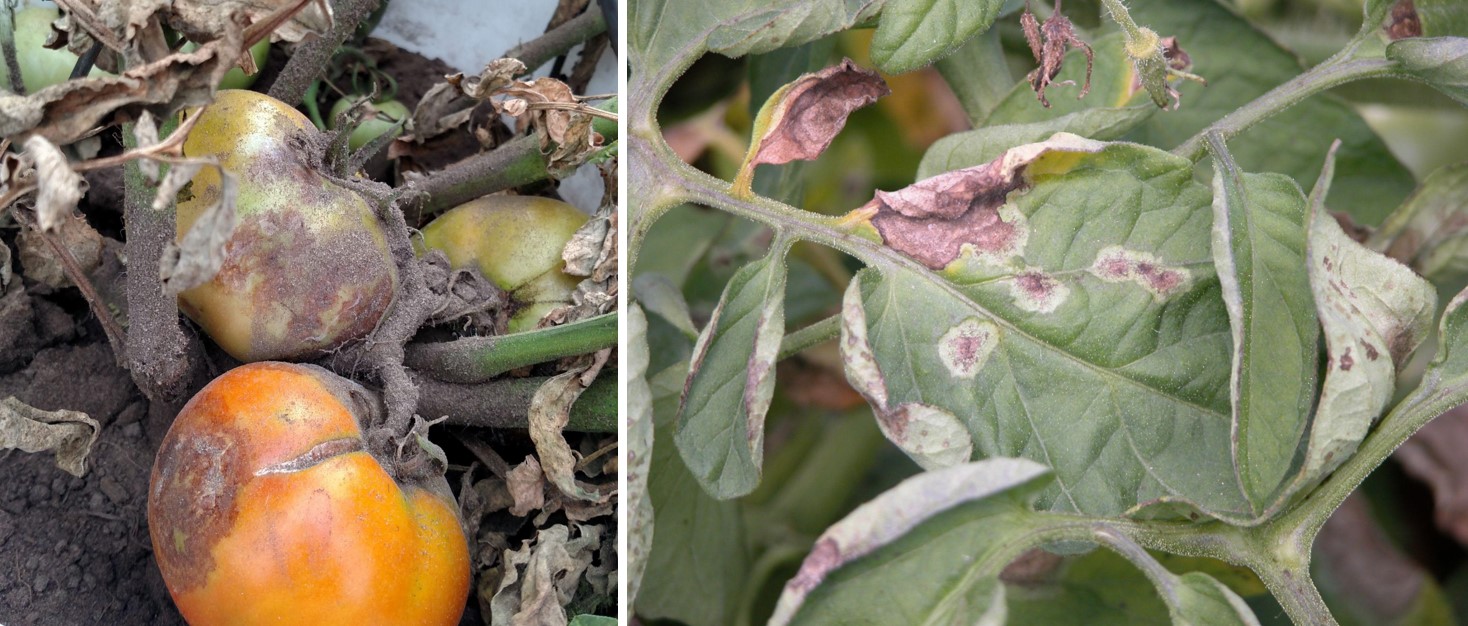
There are several highly effective fungicide sprays that can be used to protect tomato plants from late blight. Homeowners and organic growers have limited tools available and may not be able to hold the disease once it starts. Conventional growers who use fungicides as part of their overall disease program for early blight, Septoria and anthracnose will provide some protection against late blight, especially early in the season. If late blight disease pressure increases, adding late blight specific fungicides to the spray program will be needed.
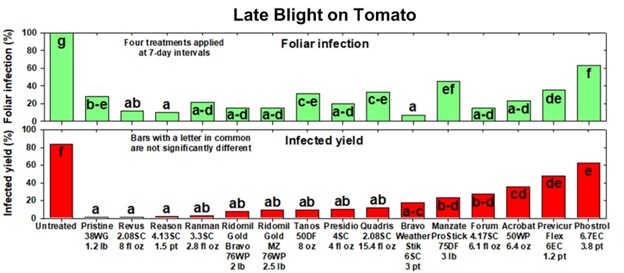
Onions and garlic
Early transplanted sweet onions are putting on size, and some are being harvested. Garlic harvest and curing is in full swing. Once cured, sort and save the largest bulbs for busting up as seed for planting this fall as next year’s crop. Some growers have experimented with allowing scapes to persist on some varieties, and for bulbils to form on their ends to plant in the fall instead of cloves. This usually reduces bulb size, and most often the planted bulbils will not make a multi-clove bulb in the first year. Instead, they will make a mono-bulb that needs another year to divide into the familiar cloves.
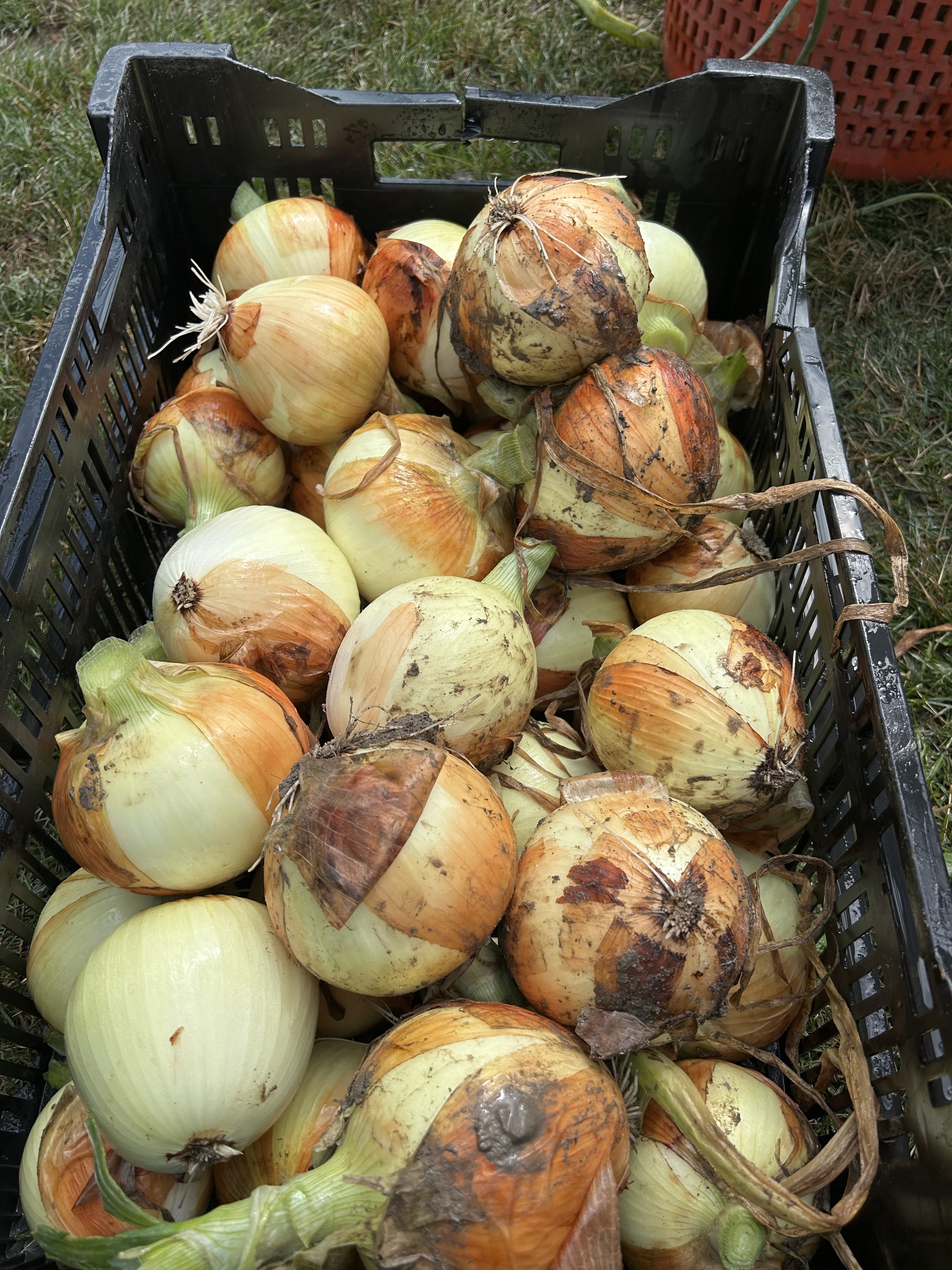
Root crops and potatoes
Late blight has been detected on potatoes and tomatoes in southwest Ontario. See the tomato section above for more information.
Metribuzin is one herbicide that can be used in potatoes to burn down smaller weeds and provide some residual control. Interestingly, crop safety depends to some degree on potato variety. Learn everything you need to know in this super-duper factsheet.
Cercospora has been reported on table beets. This is a common foliar pathogen of beets that shows up as pale necrotic spots with a reddish colored margin. The loss of tissue in the necrotic areas can leave a shot-hole type appearance that may resemble insect feeding. Cercospora can greatly reduce the quality of beets sold with their leafy tops. Using fungicides in a timely manner can prevent this leaf spot. Commonly relied on fungicides include those representing the strobilurins. Researchers that focus on sugar beets have been battling a strobilurin resistant Cercospora population making control of this leaf blight especially difficult. Rotating among the available fungicides that have a different mode of action is important.
Sweet corn
The corn earworm management season has begun as plantings produce green silks attractive to egglaying females. Earworm can be managed with pyrethroid, diamide and spinosyn insecticides. Pyrethroids are effective when moth pressure is not high, and include Hero, Ambush/Pounce, Asana, Baythroid, Brigade, Mustang Maxx and Warrior. Products with the diamide chlorantraniliprole (Besiege, Vantacor, Coragen) or the spinosyn spinetoram (Radiant, Intrepid Edge) are effective options for periods with high pressure. Spraying can be discontinued once corn has 90% brown silks, as it’s the green silks that attract egglaying females.
Overall corn earworm is present in many parts of the Midwest but as of today extremely high numbers have not been reported. Corn earworm has been present in pheromone traps MSU Extension is checking, and some west central scouts have captured moths as well, with some higher numbers in select locations (pointing to the value of having your own trap). Some growers have also reported earworm damage in early harvests. To our south, nightly earworm captures were mostly in the single digits for the past week in Purdue’s trapping network and present but low in Ohio State’s trapping network. The insect forecast website suggests little to no risk of additional corn earworm migration through Sunday, July 21.
|
Corn earworm captures. Total in trap for week1 (avg # per night2). |
|||||
|
Week |
Monroe Co |
Washtenaw Co |
Oceana Co |
Ottawa Co |
Lapeer Co |
|
7/15 |
0 (0) |
1 (.14) |
8 (1.1) |
- |
2 (0.3) |
|
7/8 |
0 (0) |
2 (.2) |
8 (1.1) |
14 (2.0) |
|
|
6/30 |
- |
- |
5 (1.0) |
30 (6.0) |
|
|
6/23 |
- |
- |
2 (1.0) |
- |
|
|
1Total number collected since last trap check; 2The total number divided by the number of nights since the last trap check. |
|||||
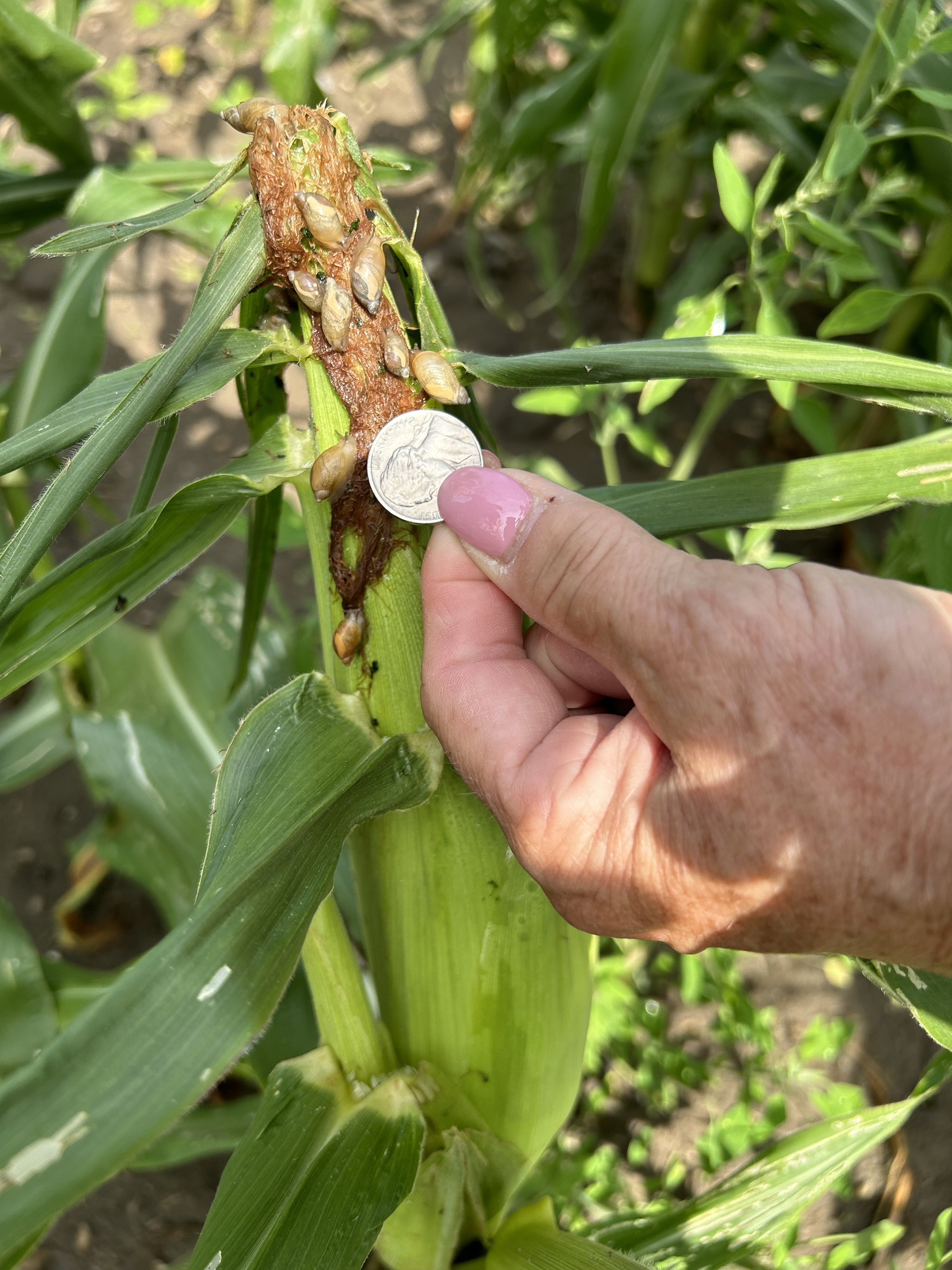
Corn smut is common in most places where corn grows, but does not usually cause any significant economic losses. Learn more about corn smut in this article.

Western bean cutworm moths are flying at locations MSU Extension is monitoring, and increased numbers have been seen to our south in Ohio. Read the recent Ohio State report for information on scouting for this pest.
|
Western bean cutworm captures. Total in trap for week1 (avg # per night2). |
|||||
|---|---|---|---|---|---|
|
Week |
Monroe County |
Washtenaw County |
Oceana County |
Ottawa County |
Saginaw County |
|
7/15 |
6 (.75) |
26 (3.7) |
12 (1.7) |
- |
133 (19) |
|
7/8 |
5 (0.7) |
29 (3.6) |
3 (0.4) |
127 (18.1) |
26 (3.7) |
|
6/30 |
- |
- |
0 (0.0) |
11 ( 2.2) |
5 (0.7) |
|
6/23 |
- |
- |
0 (0.0) |
- |
5 (0.7) |
|
1Total number collected since last trap check; 2The total number divided by the number of nights since the last trap check. |
|||||
Events
- July 18, 7-8 a.m., Field Crops Virtual Breakfast Series: White Mold - Tar Spot Spraying – Will it Pay?
- July 23, 6-8 p.m., Veggie Vibes at SWMREC
- July 25, 7-8 a.m., Field Crops Virtual Breakfast Series: Hot Topics Q&A Session
- Aug. 1, 7-8 a.m., Field Crops Virtual Breakfast Series: Cover Crops After Wheat
- Aug. 2, 10 a.m.-2 p.m., Organic Inspection Field Day at The North Farm
- Aug. 8, 7-8 a.m., Field Crops Virtual Breakfast Series: MSU Diagnostic Lab Topics
- Aug. 8, Potato Field Day at the Montcalm Research Center, Lakeview, MI
- Aug. 12, Small Farms Conference, Benzonia, MI
- Aug. 13, Farming for the Future Field Day at the West Central Michigan Research and Extension Center, Hart, MI.
- Aug. 15, 7-8 a.m., Field Crops Virtual Breakfast Series: Field Crops Nematode Update
- Aug. 20, 6-8 p.m., Veggie Vibes at SWMREC
- Aug. 20, Bean and Beet Day at the Saginaw Valley Research and Extension Center, Frankenmuth, MI
- Aug. 22, 7-8 a.m., Field Crops Virtual Breakfast Series: Lime Recommendations for Field Crops
- Aug. 22, Summer Bus Tour and Annual Field Day at the Northwest Michigan Horticulture Research Center, Traverse City, MI
- Aug. 29, 7-8 a.m., Field Crops Virtual Breakfast Series: Maximizing Wheat Yield Potential
- Sept. 5, 7-8 a.m., Field Crops Virtual Breakfast Series: Drought-Proofing Agriculture with Drainage Water Recycling
- Sept. 5, Long-Term Agroecosystems Research Field Day at the W. K. Kellogg Biological Station.
- Sept. 12, 7-8 a.m., Field Crops Virtual Breakfast Series: Grain Marketing
- Sept. 17, 6-8 p.m., Veggie Vibes at SWMREC
- Sept. 19, 7-8 a.m., Field Crops Virtual Breakfast Series: Late Season Weed Control
- Sept. 23, Field Day at the Trevor Nichols Research Center, Fennville, MI
This work is supported by the Crop Protection and Pest Management Program [grant no. 2021-70006-35450] from the USDA National Institute of Food and Agriculture. Any opinions, findings, conclusions, or recommendations expressed in this publication are those of the author(s) and do not necessarily reflect the view of the U.S. Department of Agriculture.



 Print
Print Email
Email

